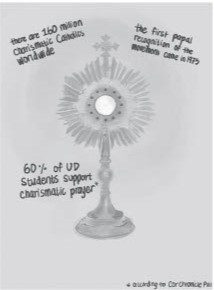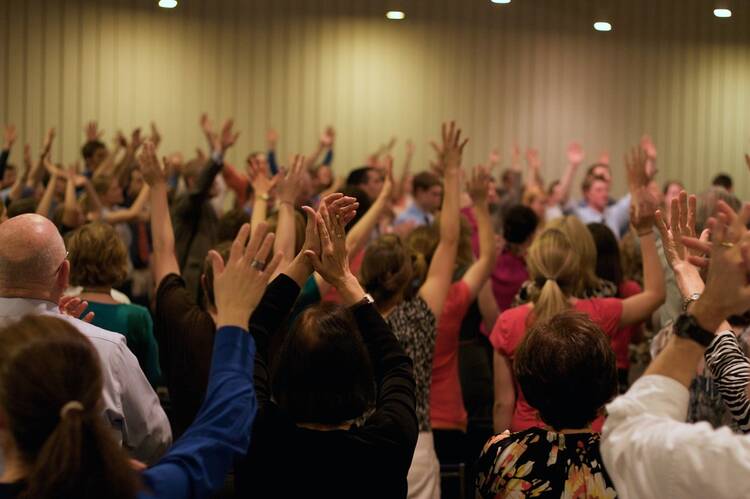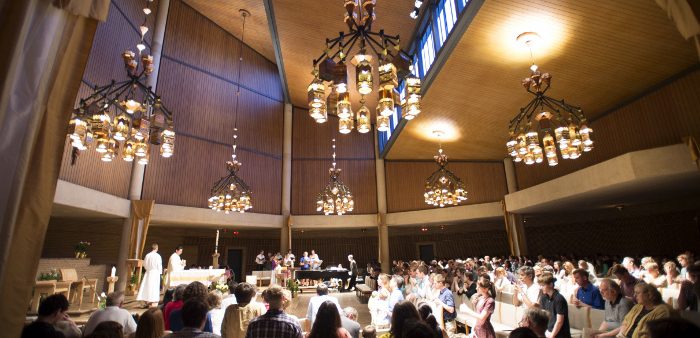
At the University of Dallas, students are privileged to enjoy daily mass, several weekly opportunities for confession, regular invitations to pray the Rosary and many other ways to develop their relationship with the Lord and honor Him. One facet of prayer not frequently seen on campus is charismatic prayer.
Although charismatic prayer has its roots in the birth of the Church, the modern charismatic revival movement developed in the 1960s among Christians from older denominations who adopted beliefs and practices similar to Pentecostals. These groups believed that the ecstatic spiritual experiences of the first Christian Pentecost, such as speaking in tongues, could and should still occur.
Catholic charismatic prayer emerged from this revival. This movement in prayer emphasized personal encounters with the Holy Spirit and spiritual gifts like speaking in tongues, healing and prophecy. In 1967, students and faculty at the Catholic Duquesne University experienced a spiritual revival and began adopting charismatic practices. This sparked a similar movement among Catholics that became known as Catholic Charismatics.
At first, the Catholic Church was skeptical of charismatic worship, which was more characteristic of Protestant services. Many students at UD have expressed a hesitancy to participate in charismatic prayer and a reluctance to bring it into the celebration of the Mass or times of Exposition. They cited a fear that it would distract from the holiness of the Eucharist or that it would be inappropriate because it does not exemplify the solemn kind of reverence found in the pews of the Church of the Incarnation.
However, all of the popes since, and including, Pope Paul IV, have endorsed the Catholic Charismatic Renewal. Shortly after proclaiming 1975 to be a Holy Year, Pope Paul VI said, “Nothing is more necessary for such a world more and more secularized, than the testimony of this spiritual renewal.” In 2019, the Holy See established C.H.A.R.I.S. (Catholic Charismatic Renewal International Service) to serve the movement.
Fundamentally, charismatic prayer is the response of the Holy Spirit dwelling in us to respond back to the love of the Father. It manifests in spontaneous worship and an active receiving of gifts of the Holy Spirit. Like any other form of prayer, it is an invitation to participate in the life of the Trinity. Charismatic prayer pursues this participation in a way that is more akin to the apostles at Pentecost than to Jesus in the Garden or at the Last Supper.

Charismatic prayer services can often look like a room of people participating in praise and worship, singing with raised hands. They may be singing in tongues. In between songs, there is often a swelling of song as people spontaneously harmonize their personal audible prayer and, depending on the structure, people may be encouraged to share whatever words they receive in prayer. Charismatic Masses often involve similar raising of hands and less choral music than seen at the Church of the Incarnation.
When asked about the definition of charismatic prayer, Father James Martin Nobles, chaplain of the Church of the Incarnation, explained how the term acts as an explanation of one’s unique call to spiritual evangelization. “I think the source of the charisma- tic movement is the life of the Trinity, and how the Father, Son, and Holy Spirit communicate with one another is very important,” Nobles said.
Sister Mary Angelica, a professor in the university’s Department of Theology, further elaborated on the presence of the Spirit in charismatic prayer. “The Holy Spirit wants to use [people] for whatever gift He wants to give – prophecy or speaking in tongues – and it’s for the sake of others, that they would convert, and that they would come to the faith or come closer to the Lord,” she said.
When asked about the more contentious definition of charisma- tic prayer – that being praise and worship in the mass – Shelby Ponikiewski, campus ministry’s faith formation and outreach minister, commented on how the university strikes a balance between those who prefer outward prayer and those who prefer silent prayer. “Students [at UD] are not as interested in praise and worship as silent adoration or Gregorian chant. But there are still UD students who do value it […] and so, we try to serve them as best we can […] so that those people can feel free to pray that way here,” she said.

Ponikiewski also added insight into how students should incorporate different types of prayer into their spiritual lives. “I feel like the main focus [of prayer] should be, regardless of what you grew up with, what you find actually helps you talk to Jesus, connect with him, have a relationship with him and be fulfilled, while at the same time being open to new experiences. Especially here at UD – people are in their end-of-adolescence and entering into young adulthood. So having an open mind towards different types of prayer that [students] haven’t experienced before I think is really healthy.”